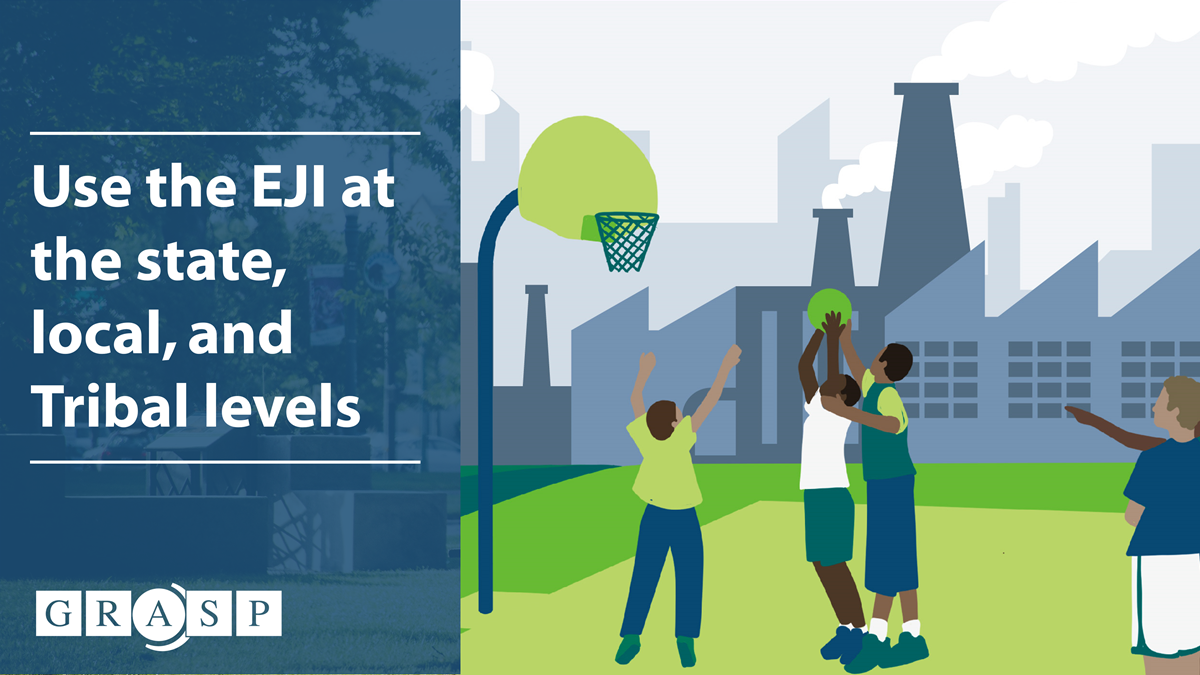At a glance
Learn how to use the Environmental Justice Index at state, local, and Tribal levels.

Overview
Download the Guidance Document
Environmental justice can only be achieved when everyone enjoys the same degree of protection from environmental and health hazards and has equal access to the decision-making process to create and function in a healthy environment. The Environmental Justice Index (EJI) helps public health officials identify and prioritize communities most at risk for the health impacts of environmental burden. The EJI is the first national, place-based tool designed to measure the cumulative impacts of environmental burdens through the lenses of human health and health equity.
This resource provides examples of how public health officials and others have used the EJI, offers a supplemental approach to identifying and mapping areas most at risk for environmental health impacts, and defines three types of environmental justice tools. This information is intended to help state, local, and Tribal government use the EJI to promote environmental justice and health equity.
Environmental Justice Index (EJI) uses
The EJI can be used to:
- Identify and prioritize areas that may require special attention or additional action in order to improve health and health equity
- Educate and inform the public about the environmental burdens in their community to inspire and empower community-driven action
- Analyze the unique, local factors driving cumulative impacts on health to inform policy and decision-making
- Establish meaningful goals and measure progress towards environmental justice and health equity
The EJI may also serve as a framework to develop new tools in states where environmental justice mapping and screening tools have yet to be developed.
EJI use examples
The EJI can provide a valuable national perspective to local or regional environmental justice challenges, by bringing attention to the scope of an issue and enabling broad geographic comparisons.
New York tolling plan environmental assessment
The New York Metropolitan Transit Authority (NY MTA) used the EJI to analyze the potential effects of a Central Business District Tolling Alternative on low-income and minority populations in New York and New Jersey. Following a U.S. Department of Health and Human Services (HHS) recommendation, the NY MTA used the EJI and other environmental justice mapping tools to identify communities with pre-existing pollution and chronic disease burdens. The NY MTA prioritized these communities for the implementation of several health protective measures recommended by HHS.
Chesapeake Bay report card
The University of Maryland Center for Environmental Science (UMCES) integrated the EJI into their 2023 Chesapeake Bay Eco Health Report Card. The EJI enabled UMCES to compare tracts across multiple states within the Chesapeake Bay watershed. The UMCES Chesapeake Bay Report summarizes disparities among the watersheds' urban, suburban, and rural communities. The UMCES asserts that addressing environmental justice is crucial for the long-term health and sustainability of the Chesapeake Bay watershed.
A supplemental approach to environmental justice
The EJI uses nationally consistent data to build upon environmental justice screening and mapping tools that have previously been developed at the local, state, and federal levels. The EJI is not intended as a replacement for local, state, and federal tools; however, it may serve as a useful supplement to such tools by:
- Providing national-level comparisons that may bring additional attention to local issues,
- Focusing on the cumulative impacts of environmental burdens on health, and
- Serving as additional validation of the lived experiences of communities impacted by poor environmental conditions and other social determinants of health.
Using EJI for Tribal nations
There are several important limitations to note when using the EJI to explore data for Tribal lands. While the EJI includes data for Tribal lands that intersect U.S. census tracts, census tracts do not directly align with the jurisdictional boundaries of Tribal nations. This means that, in some cases, data for Tribal lands are combined with data for land that is just outside of Tribal nation boundaries.
Additionally, it is important to note that while the EJI always endeavors to use the most accurate and authoritative data available, authoritative datasets do not always accurately reflect Tribal lands, Tribal nations, and the lived experiences of Tribes and Indigenous peoples. Improvements to the EJI are intended to be ongoing process that includes partnership and meaningful engagement with Tribes, Indigenous experts, and Indigenous Knowledge holders. Additional engagement with Tribes will be necessary to ensure:
- Future versions of the EJI are able to reflect the lived experiences of Tribes more accurately,
- Indigenous Knowledge and values are incorporated into the EJI in a way that protects the intellectual property of Indigenous experts and Indigenous Knowledge holders
- That the EJI is more useful and empowering for Tribal nations experiencing environmental injustice.
The EJI compared to existing tools
Most environmental justice mapping and screening tools have a similar objective: to help highlight existing or potential future environmental justice concerns, so that they may be addressed. However, there is no single method to accomplish this goal, and each approach involves unique considerations and trade-offs that determine proper use and interpretation.
Broadly speaking, most environmental justice mapping and screening tools fall into three categories: percentile-based tools, threshold-based tools, and direct data tools. The EJI is an example of a percentile-based tool. The EJI Technical Documentation describes EJI methodology in-depth.
Types of environmental justice tools
Percentile-based tools

Threshold-based tools

Direct data tools

For more information:
- Explore the EJI online.
- Contact the EJI Coordinator at eji_coordinator@cdc.gov.
- Send media inquiries to placeandhealth@cdc.gov.

